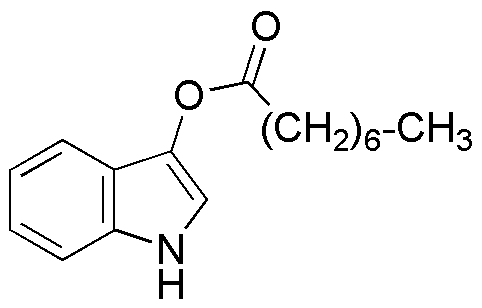3-Indoxyl caprylate is widely utilized in research focused on:
- Biotechnology: It serves as a substrate for the detection of β-glucuronidase activity in microbial assays, aiding in the identification of specific bacterial strains.
- Pharmaceutical Development: This compound is explored for its potential as a prodrug, which can enhance the bioavailability of therapeutic agents, making medications more effective.
- Food Industry: It is used in flavoring and fragrance applications, providing a unique aroma profile that can enhance the sensory experience of food products.
- Agricultural Research: The compound is investigated for its role in developing biopesticides, offering an eco-friendly alternative to traditional chemical pesticides.
- Analytical Chemistry: It is employed in chromatography as a standard for the analysis of indole derivatives, ensuring accurate and reliable results in research laboratories.
General Information
Properties
Safety and Regulations
Applications
3-Indoxyl caprylate is widely utilized in research focused on:
- Biotechnology: It serves as a substrate for the detection of β-glucuronidase activity in microbial assays, aiding in the identification of specific bacterial strains.
- Pharmaceutical Development: This compound is explored for its potential as a prodrug, which can enhance the bioavailability of therapeutic agents, making medications more effective.
- Food Industry: It is used in flavoring and fragrance applications, providing a unique aroma profile that can enhance the sensory experience of food products.
- Agricultural Research: The compound is investigated for its role in developing biopesticides, offering an eco-friendly alternative to traditional chemical pesticides.
- Analytical Chemistry: It is employed in chromatography as a standard for the analysis of indole derivatives, ensuring accurate and reliable results in research laboratories.
Documents
Safety Data Sheets (SDS)
The SDS provides comprehensive safety information on handling, storage, and disposal of the product.
Product Specification (PS)
The PS provides a comprehensive breakdown of the product’s properties, including chemical composition, physical state, purity, and storage requirements. It also details acceptable quality ranges and the product's intended applications.
Certificates of Analysis (COA)
Search for Certificates of Analysis (COA) by entering the products Lot Number. Lot and Batch Numbers can be found on a product’s label following the words ‘Lot’ or ‘Batch’.
*Catalog Number
*Lot Number
Certificates Of Origin (COO)
This COO confirms the country where the product was manufactured, and also details the materials and components used in it and whether it is derived from natural, synthetic, or other specific sources. This certificate may be required for customs, trade, and regulatory compliance.
*Catalog Number
*Lot Number
Safety Data Sheets (SDS)
The SDS provides comprehensive safety information on handling, storage, and disposal of the product.
DownloadProduct Specification (PS)
The PS provides a comprehensive breakdown of the product’s properties, including chemical composition, physical state, purity, and storage requirements. It also details acceptable quality ranges and the product's intended applications.
DownloadCertificates of Analysis (COA)
Search for Certificates of Analysis (COA) by entering the products Lot Number. Lot and Batch Numbers can be found on a product’s label following the words ‘Lot’ or ‘Batch’.
*Catalog Number
*Lot Number
Certificates Of Origin (COO)
This COO confirms the country where the product was manufactured, and also details the materials and components used in it and whether it is derived from natural, synthetic, or other specific sources. This certificate may be required for customs, trade, and regulatory compliance.


